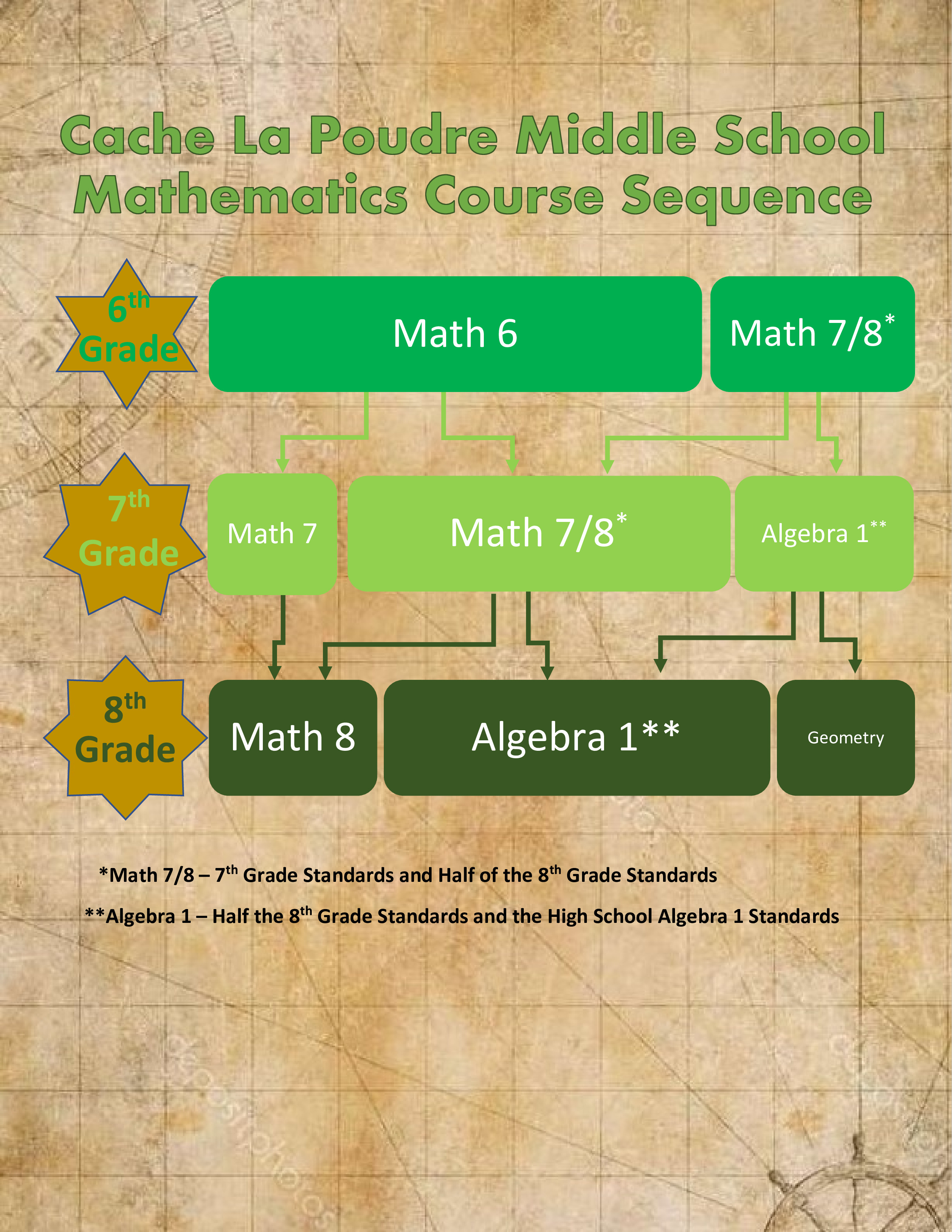Mathematics at CLP Middle School

Math 6 (6th grade)
In grade six, your child will learn the concept of rates and ratios and use these tools to solve word problems. Students will work on quickly and accurately dividing multi-digit whole numbers and adding, subtracting, multiplying, and dividing multi-digit decimals. Students will extend their previous work with fractions and decimals to understand the concept of rational numbers—any number that can be made by dividing one integer by another, such as ½, 0.75, or 2. Students will also learn how to write and solve equations—mathematical statements using symbols, such as 20+x = 35—and apply these skills in solving multi-step word problems. Students are also introduced to statistics, data collection and evaluation. Students will learn the area of triangles, parallelograms, and composite polygons and the formulas of each as well as the surface area and volume of some 3-dimensional shapes. The 6th grade course also includes plotting positive and negative numbers in the coordinate plane.
MATH 7 (7th Grade)
In this course students will gain an understanding about and be able to apply rational numbers. Students will explore ratios and proportions to develop an understanding of linear functions and be able to solve single-variable equations. They will compare data distributions and be able to compare differences between populations. Finally, students will analyze geometric figures, calculating area, surface area, and volume. Content is organized into four critical areas, or units. The Mathematical Practice Standards apply throughout each course and, together with the content standards, prescribe that students experience mathematics as a coherent, useful, and logical subject that makes use of their ability to make sense of problem situations.
Math 7/8 (accelerated 6th grade and 7th grade)
In grade seven, students will further develop their understanding of rates and ratios, using tables, graphs, and equations to solve real-world problems involving proportional relationships. Students will also work on quickly and accurately solving multi-step problems involving positive and negative rational numbers—any number that can be made by dividing one integer by another, such as ½, 0.75, or 2. Additionally, students will expand their knowledge of geometry and apply the properties of operations to solve real world problems involving the measurement of multi-dimensional objects. They will also have some 8th grade concepts that will take their understanding of unit rates and proportional relationships to a new level, connecting these concepts to points on a line and ultimately using them to solve linear equations that require them to apply algebraic reasoning as well as knowledge of the properties of operations. Students will also expand their understanding of numbers beyond rational numbers to include numbers that are irrational.
MATH 8 (8th Grade)
In 8th grade, students will build upon their knowledge and understanding of generating equivalent expressions, ratios and proportions, exponents, and volume of prisms gained in 6th and 7th grade. In this course, students will apply their knowledge of expressions both algebraically and geometrically. Students will explore congruence and similarity of figures in the coordinate plane and write algebraic expressions to describe the transformations. Students will use their knowledge of generating equivalent expressions to solve single-variable linear equations. They will analyze the solution set to include one solution, no solutions, and infinitely many solutions. Students will build upon their understanding of proportional relationships to create linear functions in a graph, table of values, equation, and story problem. They will then examine the similarities and differences between linear and non-linear models, exploring the commonalities and differences among rational and irrational numbers. Students will approximate the location of simple square and cube root values on a number line. Students will expand upon their understanding of volume of prisms to know and apply the formulas for volume of cylinders, cones, and spheres. Students will apply their knowledge of linear relationships to analyze and make conjectures about two-way data displays, tying together the components of this course. The 8th grade standards have been divided into six critical areas, or units, as follows.
ALGEBRA 1 (accelerated 7th grade and 8th grade)
The fundamental purpose of this course is to formalize and extend the mathematics that students have learned. Because it is built on the middle grades’ standards, this is a more ambitious version of Algebra I than has generally been offered. The critical areas, called units, deepen, and extend understanding of linear relationships. Students will extend their skills using tables, graphs, and equations and solve linear equations and inequalities and systems of linear equations and inequalities. Students will advance their familiarity of the number system to include irrational numbers. Students will produce equivalent expressions and use formulas. They will learn exponential relationships and along with linear relationships will be applying exponential and linear models to data that exhibit linear and non-linear trends. Students will simplify polynomials and be introduced to quadratic relationships where students will engage in methods for analyzing, solving, and using quadratic functions. Students will investigate and explore mathematical ideas and relationships and develop multiple strategies for analyzing complex situations. Students will analyze situations verbally, numerically, graphically, and symbolically. The Mathematical Practice Standards apply throughout each course and, together with the content standards, prescribe that students experience mathematics as a coherent, useful, and logical subject that makes use of their ability to make sense of problem situations. Algebra will develop their thinking, specifically logic, patterns, problem solving, deductive and inductive reasoning. This is a high school credited course.
GEOMETRY (accelerated 8th grade)
The fundamental purpose of the course in Geometry is to formalize and extend students' geometric experiences from the middle grades. Students explore more complex geometric situations and deepen their explanations of geometric relationships, moving towards formal mathematical arguments. Important differences exist between this Geometry course and the historical approach taken in Geometry classes. For example, transformations are emphasized early in this course. Close attention should be paid to the introductory content for the Geometry conceptual category found in the high school CCSS. The Mathematical Practice Standards apply throughout each course and, together with the content standards, prescribe that students experience mathematics as a coherent, useful, and logical subject that makes use of their ability to make sense of problem situations. The critical areas, organized into six units are as follows: Congruence, Proof, and Constructions; Similarity, Proof and Trigonometry; Connecting Algebra and Geometry through Coordinates; Circles With and Without Coordinates; Extending to Three Dimensions; Applications or Probability. This is a high school credited course.



